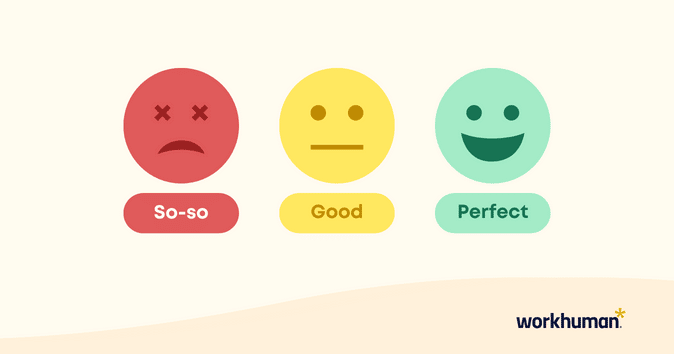Employee Satisfaction Survey: 21 Questions, Examples, and More…

Do you ever wonder how your staff feels about their employer-employee relationship? Or how they perceive the organization? What about their work-life balance?
HR managers all over the world dwell on these questions, and as it happens, conducting an employee satisfaction survey is one of the best ways to answer this question.
And leaders could use all of the help they can get considering approximately 35% of American workersOpens in a new tab are unhappy in their jobs. Read on to learn all about creating top-notch satisfaction surveys here.
Why should you conduct an employee satisfaction survey?
Conducting regular satisfaction surveys can provide vital data on how company culture is perceived, help HR professionals understand issues impacting engagement and productivity, and give employees a voice.
Additionally, responding to organizational feedback makes employees feel valued and more likely to contribute to organizational growth initiatives.
So let’s dive into some satisfaction stats!

Employee satisfaction vs. engagement
These two terms can be a little complicated. However, the gist is that satisfied employees are engaged employees. Engaged employees will have the passion to go the extra mile for the company, which will only happen if they have enough job satisfaction to drive them.
| Engagement Level and Percentage in the Global WorkforceOpens in a new tab | How Engagement Relates to Satisfaction |
| Highly engaged – 35% | Employees are satisfied, supported, and able to work with passion. |
| Unsupported – 22% | Employee is engaged but lacks the support, which might drive satisfaction down. |
| Detached – 17% | Employees might have enough satisfaction and support but without apparent engagement. |
| Disengaged – 26% | Employees aren’t satisfied, supported, or engaged, which translates to low productivity. |
There’s a catch, though.
Just because you have decent employee morale doesn’t mean it’ll translate to engagement at a 100% rate.
That’s because satisfaction covers a lot of other factors, and it comes in different molds. For instance, some people might find job satisfaction in good pay, a peaceful work climate, and decent hours. That doesn’t necessarily mean that they’re passionate about their job.
So, why even bother with employee satisfaction surveys if they won’t guarantee work engagement?
Well, there’s so much more that you’ll get from a high employee satisfaction rate, like retention and customized compensation/benefits plans.
Signs that you need to survey employees
While staying on top of your survey schedule can significantly boost the company’s future roadmap. Sometimes it’s a necessary fix for urgent problems.
For instance, you might have to conduct a survey if you’ve noticed that you have a problem with employee retention.
In that case, you might not even have the time to wait for the result of the annual surveys. Instead, you can jump right ahead with a customized survey that you can use as a guideline for solving the issue.
So, watch out for these warning signs:
- High turnover rate
- Sudden drops in productivity
- Increase in complaints received by HR
- Repetitive and unexplained employee behavioral patterns
- Stunted organization growth
Finding the right survey cadence
One major challenge when you’re conducting satisfaction surveys is hitting the right frequency. Overdo it, and you’ll face survey fatigue. Underdo it, and you’ll miss on important indicators.
So, how often should you survey employees?
Some HR managers opt for an annual employee survey, which is not bad per se. In fact, it might be suitable for companies or departments that aren’t too concerned with growth, but more so looking to keep the status quo.
However, if you go with that option, you’ll need to make the surveys lengthier. That might be a bit of a deterrent for some employees who’ll put it off or rush through the questions, giving you inaccurate results.
In most cases, pulse surveys every 1-6 months might strike the right balance for a lot of dynamic work climates. Shorter, more frequent surveys also allow you to tailor questions to specific goals or outcomes, which generally make them more effective overall.
Plus, pulse surveys help identify opportunities and gauge reactions to change in the workplace, making it easier to facilitate growth and create a positive work environment.

Why should you measure employee satisfaction?
Measuring employee satisfaction puts you one step closer to identifying where the system fails. This way, you can narrow down the reforms you need to tackle either as the HR team or as members of the C-suite.
The key here is being able to touch on all the factors that contribute to satisfaction, but you’ll also need to monitor the right parameters.
Here’s how:
Employee satisfaction factors
In order of their descending impactOpens in a new tab on satisfaction, here are the main factors to consider:
- Recognition and reward
- Relationships with the immediate supervisor
- Effective communication
- Role fitting and clarity
- Culture and ethics
- Adequate training programs
- Working conditions
- Teamwork
- Career growth and promotions
A different way to look at things here is to consider positive aspects like recognition, responsibility, and personal growth as factors that boost satisfaction. Meanwhile, competitive pay, job security, and work conditions are fundamental or “hygiene” factors.
Measures of job satisfaction
Employee satisfaction, in itself, is sometimes considered a KPI, albeit an aggregate one. That said, a few parameters that can help you gauge the satisfaction level are:
- Net promoter scores
- Frequency and flow of informal conversations between peers
- Productivity figures
- Absenteeism
- Skill-to-task suitability
Common challenges with measuring satisfaction (and solutions)
Unfortunately, the road to conducting your first employee satisfaction survey might be bumpy.
However, if you know the common challenges and prepare for them, you can make things a bit easier for you and your HR team.
Here are the common mistakes and how to avoid them:
Unresponsiveness bias
Having a portion of employees not participating in satisfaction surveys is normal. The problems start when management neglects how different the absent points of view might be from the data at hand.
That’s mostly because of unrealistic response rate extensions, but we’ll get to that in a minute!
Retesting reliability
It’s great to see the numbers bounce from your last pulse survey, but is it really a reliable indicator?
Suppose the first run was on a Monday when people were particularly cranky, and the second one was on a Friday right after they ordered some pizza at the office. In that case, you’re adding way too many variables to the equation.
Call it a causation-correlation issue or sample contamination, but either way, it ruins the measurement integrity.
The ideal solution is to never jump to assumptions until you’re done reviewing all the data. You can also try to replicate the same surveying conditions every time to keep the long-term satisfaction level as the main variable.
Stretched analysis phase
It’s important to analyze the surveys, but if employees don’t see quick results, they’ll be less likely to participate again.
So, extract the data as soon as possible to be able to enact changes. This way, the next pulse survey questions can be a reliable measure of whether the action plan was effective or not.
Generalized inquiries
Often, you’ll see surveys that group inquiries like pay and benefits into one question. After all, they seem relatable enough, and it’s tempting to try and hit two birds with one stone.
However, it could leave employees confused since they might have two different satisfaction levels for each of those inquiries. So, try to narrow down your questions as much as possible.

27 employee satisfaction survey questions
Satisfaction surveys aren’t one-size-fits-all. After all, each work environment will have different needs and parameters. That’s why HR should have a heavy hand in tweaking the survey.
That said, it’s possible to take the core employee satisfaction survey questions and customize them to match your goals and current challenges.
You might even be able to insert a few employee engagement questions to gauge how well the satisfaction will translate to passionate work.
Here are a few questions to consider using:
Role recognition
- Do you get a feeling of personal accomplishment from your daily work?
- How well would you say that the job description matches your current roles?
- Do you feel like your roles and efforts are appreciated by your supervisors?
- Are your daily tasks closely related to your professional skills?
- How often do you get to work on the aspect you love most about the job?
Work climate
- Do you feel confident in the work accomplished by your peers?
- Would you recommend adding more members to carry the workload?
- How often do you share work-related advice with your teammates?
- Is your office equipped with all the necessary tools to cover your tasks?
- Do you see your teammates as competition or aid?
Compensation and benefits
- Do you find your benefits package competitive?
- Is your pay rate enough to keep you from taking a second job?
- How likely are you to get leave time when you need it?
- How much would you like to change about your current benefits package?
Work-life balance
- How stressed do you feel on a typical workday?
- How stressed do you feel on a typical workday?
- Do you feel like you have been offered the support and flexibility necessary to thrive at work?
- How often do you finish/work on tasks at night or on the weekends?
- Are you happy with the PTO that has been allocated to you by your employer?
- Have you ever missed/postponed a personal event due to your workload?
Managerial communication
- Would you describe all staff meetings as essential?
- How clear is the information that gets passed down from your managers about the company’s general vision?
- Are you often confused by the goals and objectives of a task/project?
- So you see a clear line of promotion for yourself through your supervisor’s recommendations?
Training adequacy
- Do you often feel like you have to use unfamiliar tools?
- When was the last time your immediate supervisor mentored you?
- How well do the training sessions translate during practical tasks on the job?

Planning and implementing a successful satisfaction survey
We’ve covered that conducting employee satisfaction surveys is vital for the workflow in any organization, but that’s usually easier said than done.
From low response rates to untangling the data mess, there’s a lot to deal with before completing a successful survey.
Tips for getting employee feedback
Gathering feedback is a challenging feat since people rarely jump on the opportunity to sit down and fill out a survey.
It’s nearly impossible to get a 90-100% response rate, especially with larger companies. In fact, this is also the case with other surveys and questionnairesOpens in a new tab, not just the employee-based ones. So, what’s actually a good rate to expect here?
In most cases, anything over 70% is acceptable. However, you’ll want to avoid dropping under 50% since you want the changes driven by the survey analysis to apply to more than half of your employee base.
And while getting a high participation rate isn’t easy, attempting to force employees to complete surveys by tying them to rewards or deductions won’t work either; it could compromise the integrity of the results if employees are filling it out for the wrong reasons. Instead, you can consider a few tips and tricks to boost your response rates:
- Get all management levels on board with the survey’s scope to help promote its importance.
- Communicate the purpose of the survey and what changes employees could see as a result of engaging.
- Schedule the survey away from periods of high workloads.
- Give the employees enough time to complete the survey at their own pace.
- Make the survey easily accessible and keep it short with an average fill-time of 5-20 minutes.
- Don’t use overly flowery and positive statements since they could make the survey seem like a pointless formality.
- Avoid posing intrusive questions that touch on irritable or private matters.
- Maintain the right cadence to keep the data updated without overburdening the employees with surveys every week or so.
- For larger companies, try conducting a focus group to evaluate the survey’s design first.
Effective types of survey questions
Asking the right questions isn’t enough. You also need to think about how to ask your question to get quantifiable data at scale or collect detailed answers from participants. This means re-phrasing the core questions into one of the known survey inquiry molds.
- Sliding Scale: Allows the respondent to grade their satisfaction into numerical values.
- Matrix: Mainly suitable for Likert-scale questions.
- Yes/No: Used mainly to segment or classify respondents.
- Nominal Multiple Answers: Works for grading answers and segmenting responses.
- Dropdowns: Suitable for demographic-based questions (department, age, etc.)
- Ranking Slots: Can be used to rank top-rated benefits and workplace demands.
Close-ended questions are usually a better fit for companies that aim to analyze trends over time.
Using one open-ended question at the end provides a good opportunity to gauge the employee’s expectations from this survey. Just keep in mind that it’ll be harder to quantify the data from open-ended survey questions than the ones with finite answers.
Anonymity in employee surveys
Allowing respondents to fill in the survey anonymously seems like a flexible option, but it comes with its own pitfalls.
So, before you decide whether anonymous responses are a good idea for your job satisfaction survey, consider these pros and cons:
| Pros | Cons |
| Could boost the response rate | Makes it harder to follow up with changes in the next pulse surveys |
| Provides honest feedback | Provides less specific data for trend survey analysis |
| Eliminates bias |
A good compromise here would be using confidential employee surveys that take the respondent’s personal info but limit who gets access to it. However, if they’re not done right, you compromise employee trust, and it’ll all backfire very quickly.
Software solutions
One of the ways to ensure a successful satisfaction survey is to be able to lay out the data neatly for the C-suite executives to be able to come up with action plans. However, sorting the responses and creating infographics is often time-consuming.
Using pulse survey tools with analytics can significantly cut this hassle by offering organized and interactive dashboards.
Additionally, the Smart Sampling feature helps customize the survey timing and questions for each employee to cut down on survey fatigue.
The best part is that you’ll also get to see how your company’s data compares to other businesses in similar fields.

Free survey templates and online resources
While you can create your own survey from scratch using software solutions, you might need a few pointers to nudge you in the right direction.
You can check out these free staff satisfaction resources to help you out:
- Dexform’s four-page questionnaireOpens in a new tab
- Alaska’s Department of Transport and Public Facilities’ reportOpens in a new tab
- One-page satisfaction survey templatesOpens in a new tab

FAQs:
Let’s take a look at some of the frequently asked questions regarding measuring employee satisfaction:
What is the purpose of an employee satisfaction survey?
Employee satisfaction surveys gauge how happy the workforce is with the current system. This includes everything from the onboarding programs to the equitable benefits.
The goal here is to pinpoint problems and solve them in an attempt to boost productivity and retain employees longer.
What are the different types of job satisfaction surveys?
The main two approaches to employee satisfaction surveys are the objective and descriptive models. The objective one offers a finite range of answers, while the descriptive one relies more on open-ended questions.
The most commonly used templates have structured layouts with close-ended questions since they’re the easiest to answer and analyze.
How do I create an employee survey?
Since physical survey papers are getting more and more absolute, you’re better off putting your question list on a digitized survey form. Then, you’ll have to iron out aesthetic factors (formatting and color schemes) before distributing the forms to the workforce.
Alternatively, you can use all-in-one solutions to speed up the process.

Conclusion
An employee satisfaction survey is something that seems small, but has a big impact on overall employee morale. By gauging employee feedback employers are better able to understand what their employees need from them to do their best work.
About the author
Sarah Bloznalis
Sarah Bloznalis is a content marketing specialist at Workhuman from Dorchester, Mass.